Greetings from Palmia Observatory
Well its been a while since we last posted. It has just been a trying time of year, but let's mention a few items hopefully of interest to the physicist wannabes.
First up is that the winter AAS meeting, AAS241, is being held in Seattle, WA and as a hybrid meeting online. As a physicist wannabe or armchair cosmologist you can easily meet the requirements to sign up as an amateur affiliate member of AAS and get bid discounts on meeting fees. So check out the details and sign up and we will see you online.
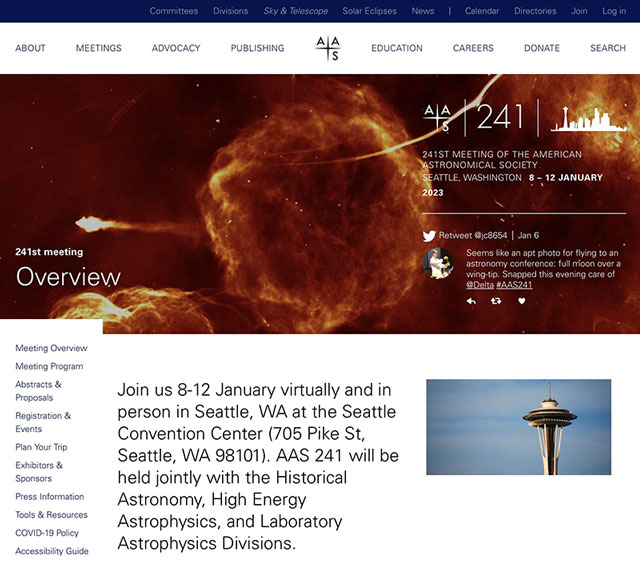 |
| AAS241 Meeting in Seattle, WA (Source: www.aas.org) |
I wanted to attend the live version but can't really be travelling right now and besides the AAS has decided to impose a mask mandate on all attendees. Hmm, the whole country and CDC recommendations don't go that far and it is not great to sit through a live meeting and just see masks.
The last AAS meeting I attended was back in January 2020 when AAS235 held live in Hawaii (just as the world was starting to identify the oncoming pandemic). Even Resident Astronomer Peggy attended the first plenary session, but every time after that she stayed back at the hotel and I would walk back from the convention center for a Mai Tai and lunch and then play hooky the rest of the afternoon
 |
| Resident Astronomer Peggy at the AAS235 meeting in January 2020 (Source: Palmia Observatory) |
While we wait to attend the AAS241 online, we received in the mail a 3D art portrait of Astronomer Assistant Willow. The art is made of colored felt to match the hair and sticks out from the portrait frame 1-2 inches. We found an artist online at etsy.com who requested a copy of photos of Willow to judge her physique and coloring. Pretty neat; Looking good Willow!
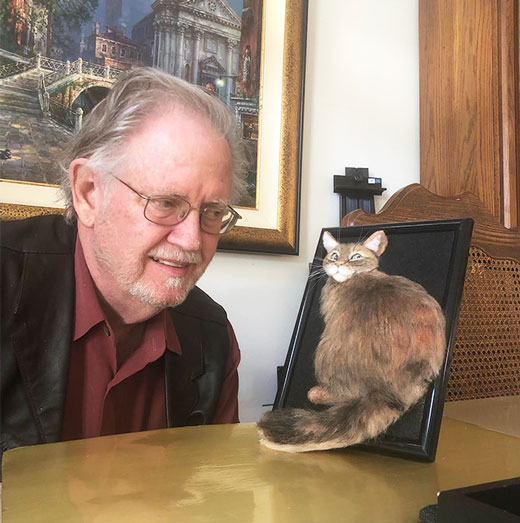 |
| 3D art (Wakuneko) portrait of Astronomer Assistant Willow (Source: Palmia Observatory) |
In other astronomical observing news, not any observing that we conducted ourselves, but this very quick ISS transit of the moon, captured by John Kraus, using a video camera. Pretty neat; thanks for that John!
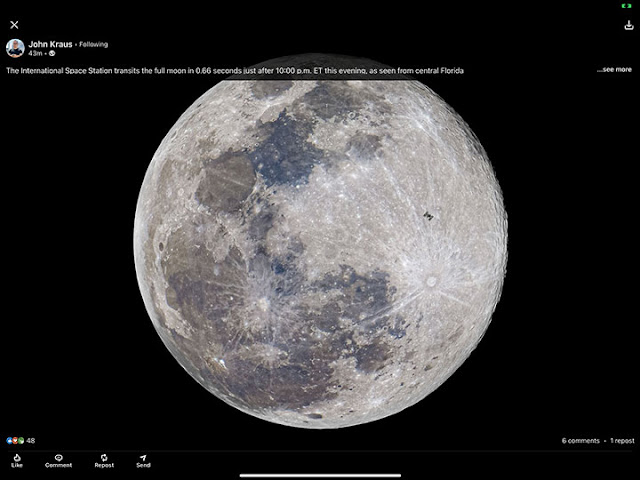 |
| ISS Transit of the Moon (Source: John Kraus, Linkedin) |
As long as we are talking about the moon, this Facebook post by Alan, indicates that the moon is not happy about us talking about the moon and blaming it for all of our problems. Hmm, yes good point; let's stop blaming the moon for our problems. Thanks Alan!
 |
| Full Moon Sick of getting the Blame (Source: Alan Nizawa, Facebook) |
Ok, now that we can't blame the moon, let's try to get back into physics by considering this lecture by Neil Turok. I knew that I was already in trouble when he started with this slide
 |
| All known physics as one equation (Source: Neil Turok) |
Ok, alright, all you physicist wannabes, now is your chance to go through some real equations from general relativity. Semiconductor Physicist John asked how to derive the metric in spacetime as outlined by general relativity. Well, I really don't know exactly how to do that myself, but in reviewing the equations in Sean Carroll's "Spacetime and Geometry", I see that one might go through this series of calculations. You can maybe start with some generalized proper distance as shown in Equation 5.5, which represents the metric and then go through the required calculations that show how the metric fits into curved space. If you differentiate the metric, as shown in Equation 3.1, you can get the connection Christoffel Symbols, when when differentiated gives us the Riemann Tensor of Equation 3.4. The Riemann tensor can be contracted to give us the Ricci tensor, Equation 3.144, and the Ricci scalar of Equation 3.146. Now we can plug these results into equation 1.5 and include the effects of mass and energy as described in Stress Energy Tensor T, and solve for the curving of spacetime.
Whew, so something like that, although I have no experience or real idea how all of that is going to work. Oh well, that is why we are still just physicist wannabes! Good luck, John, let me know how to actually do it!
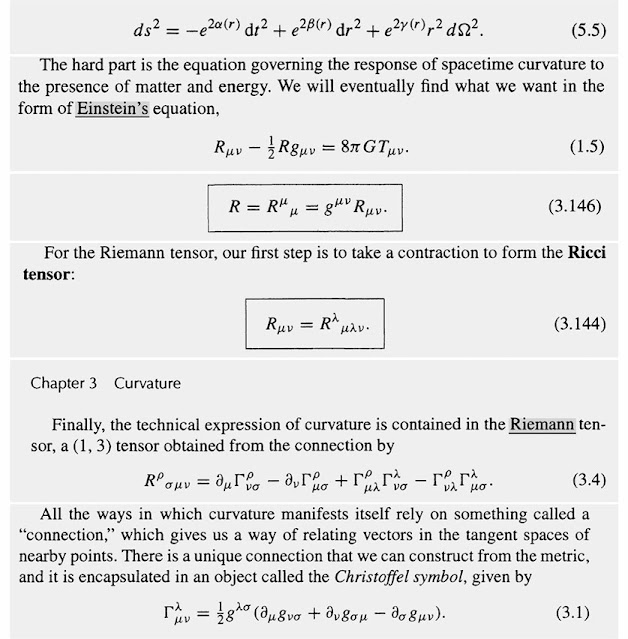 |
| Some equations needed to calculate the GR metric (Source: abstracted from Sean Carroll's "Spacetime and Geometry) |
Wow, I get tired out just looking at those equations. It might be easier to use some of the trail applications of artificial intelligence. Look at this example of asking a physics type question of ChatGPT. The question is where does nonlinearity come from if the fundamental equation of quantum mechanics, Schrodinger's Equation, is a linear equation? Well here is the response. Hmm, might not quite be what we were looking for but what would you expect.
 |
| ChatGPT responds to a question asked about physics (Source: Palmia Observatory) |
Ok, ok, you can tryout ChatGPT yourselves just by signing up for the free access online, ChatGPT has been trained on millions of sentences and understandings typical correlation between word positions, etc. without really having any real understanding.
If you want to see a more detailed question and answer example, check out how one physics instructor gave his introductory astrophysics class final exam to ChatGPT. Spoiler Alert: It passed, but just a bit less than the average student grade. Check out the video at: https://www.youtube.com/watch?v=K0cmmKPklp4
Ok, let's turn from taking astrophysics exams and consider this new 3D printed model of the Starship Launch Mount and Tower being developed in Boca Chica, TX. The model arrived in the observatory mail and was quickly assembled because the 3D printed pieces just easily snap together. If you have your own 3D printer you can do it yourself or just buy the fabricated version for $79 from online at Stardesk, Clausing Design LLC. The Mechazilla arms move up and down and the model makes "smoke" with the built-in humidifier. We are still waiting on when the orbital launch attempt will be made and in the meantime we just get to imagine what happens.
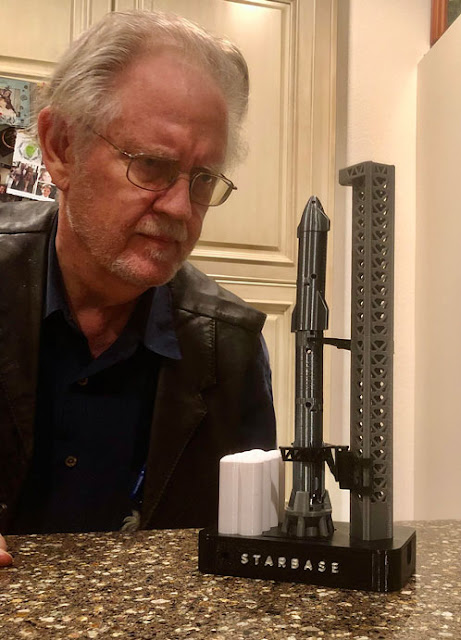 |
| 3D printed model of Starship Launch Mount and Tower (Source: Palmia Observatory) |
We have been following for sometime now the reusable rocket development by SpaceX. Now several other innovative companies are bring out their own designs for reusable designs including designs that are 3D printed. This interesting concept, by Stoke Space, combines the reentry engines in such a way that they provide an active heat shield. Not quite sure how this works but you can see that the retro rockets are arranged around the outer perimeter and provide landing thrust as well as active heat shielding. Pretty neat!
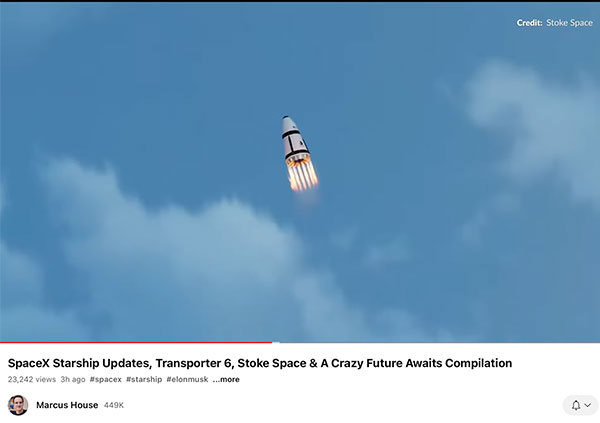 |
| Stoke Space concept of reusable design with active heat shield and engines (Source: Marcus House) |
In other space news, Sports Illustrated conducted a model shoot in a Zero-G aircraft. Here we see model, Kate Upton, twists and turns in the zero-g environment. Looking good, Kate!
 |
| Kate Upton poses in Zero-G aircraft flight (Source: Sports Illustrated) |
Wow, I don't remember anyone wearing a bikini on our Zero-G flight. Here you see a photo of Scott G. and me, all in our flight suits, no bikinis, experiencing zero-g way back in October 2021. It was a lot of fun but it was over with so quick that by the time you sort of got used to being weightless the flight was over.
 |
| Resident Astronomer George and Scott G. on Zero-g flight, October 20'21 (Source: Palma Observatory) |
Finally, as we transition into 2023, I wondered what we should put in the front trunk of our new Tesla Model Y. Well, here we see Ellie in Space coming out of the front trunk with her dog. Ellie says she doesn't have a Tesla yet, but hopes to get one soon. Ellie reports on news on Tesla and SpaceX so be sure to sign up for her YouTube channel for all the latest news.
 |
| Ellie in Space coming out of the Tesla front trunk (Source: Ellie in Space) |
Until next time,

No comments:
Post a Comment